 Add another farm podcast to your list. The U. S. Grains Council has introduced Council Cast.
Add another farm podcast to your list. The U. S. Grains Council has introduced Council Cast.
A team of Egyptian nutritionists traveled to the United States this week for a short course at the International Grains Program at Kansas State University, designed to educate the participants on the inclusion of U.S. sorghum in feed rations. Chris Corry, U.S. Grains Council senior director of international operations, gives an overview of U.S. sorghum, the Council’s success with sorghum initiatives around the world, and its first-ever introduction to the Egyptian market. Mike Deering, USGC director of communications, spoke with Corry about this initiative funded by Council member United Sorghum Checkoff Program.
You can listen to the program with this link. Now doesn’t that Mike Deering have a “radio” voice?
AgWired Mobile Browser Version Now Live
The mobile browser version of AgWired is now live. This means that if you open AgWired.com on your mobile phone you’ll get a very simple version of the website automatically. You can see what it looks like on an iPhone below and I’ve also tested it on a Blackberry. There’s no special “mobile version url” that you need to know either. Many companies have built special “phone friendly” versions of their websites but they usually require you to know a different url and they don’t necessarily offer as much functionality as this.
It functions much like a feed reader if you’re familiar with them (and I hope you are). You’ll see a list of all the posts and pages on the AgWired homepage. It will show you their title and link to them. When you go to a post you’ll see the title, the text and the photos we have posted and the comment form if you’d like to post a comment. At the bottom of the page if you scroll down is a link to take you to your phone’s “regular” version of the website. This is handy on an iPhone which has a full fledged browser if you’d like to see the page in normal view. You can click back and forth easily.
So, AgWired now loads fast on your phone and is very easy to read and use! It’s one more reason you might want to subscribe to Agwired Mobile, our text message service that delivers you a text message each time we do a post on AgWired (except during 8pm-8am central time). Visitors to the phone browser will be getting there from AgWired Mobile, our Twitter feed if they have a Twitter app on their phone, from their phone’s rss reader and by going to the site directly. I think we’ll have a lot of folks visiting and seeing the mobile version. Interested in sponsoring it? Contact Chuck Zimmerman now.
We’ll be implementing this mobile browser version on energy.agwired.com, PrecisionPays.com and WorldDairyDiary.com by tomorrow as well.

Farm Progress Show Photo Frenzy
 There are acres of photos available on line in our Flickr photo albums from Farm Progress Show 2009. The ZimmComm media team of Carly, Chuck and myself took hundreds of photos around the show and picked the best for the albums. We have 433 in the regular show album so far (Chuck still needs to load a few more) and another 129 in the BASF photo album. Feel free to download and use any photos you would like – or any of the audio we have loaded on the site – no charge!
There are acres of photos available on line in our Flickr photo albums from Farm Progress Show 2009. The ZimmComm media team of Carly, Chuck and myself took hundreds of photos around the show and picked the best for the albums. We have 433 in the regular show album so far (Chuck still needs to load a few more) and another 129 in the BASF photo album. Feel free to download and use any photos you would like – or any of the audio we have loaded on the site – no charge!
 It was a busy three days and both the weather and attendance must have been record setting. This was my first show, but from what I understand, there has probably never been a show in history that had the kind of picture perfect weather we had all three days. It’s always either cold and rainy, dry and windy, or ridiculously hot. You just can’t complain about three days of blue skies, moderate temperatures and cool breezes!
It was a busy three days and both the weather and attendance must have been record setting. This was my first show, but from what I understand, there has probably never been a show in history that had the kind of picture perfect weather we had all three days. It’s always either cold and rainy, dry and windy, or ridiculously hot. You just can’t complain about three days of blue skies, moderate temperatures and cool breezes!
 We still have LOTS more posts to do from the show, so we will be working on that over the long holiday weekend as Chuck and I celebrate our anniversary with a weekend at Lake of the Ozarks! We sincerely thank our sponsors BASF and New Holland for bringing you our coverage here on Agwired and AgLeader Technology on Precision Pays.
We still have LOTS more posts to do from the show, so we will be working on that over the long holiday weekend as Chuck and I celebrate our anniversary with a weekend at Lake of the Ozarks! We sincerely thank our sponsors BASF and New Holland for bringing you our coverage here on Agwired and AgLeader Technology on Precision Pays.
Farm Progress Show Photo Album
BASF at Farm Progress Show photo album
AgWired coverage of the 2009 Farm Progress Show
is sponsored by:  and
and 
Farm Progress Show Drive Through
While I was driving my golf cart through the Farm Progress Show yesterday I shot a short video clip so you can see what the crowd was like. You can also get a sense of how nice the weather was and is again today.
Farm Progress Show Photo Album
AgWired coverage of the 2009 Farm Progress Show
is sponsored by:  and
and 
Friends At Farm Progress Show
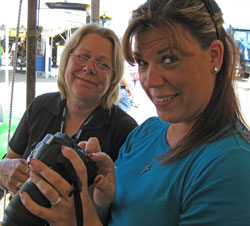 For many in the ag media, events like the Farm Progress Show are opportunities to catch up with friends. Cindy and I saw good friend Leah (Guffey) Banister. Leah’s wedding July 4th was my last trip on the road for almost 2 months. Leah used to be a farm broadcaster in Springfield, IL and now works for their convention and visitor’s bureau. She was showing us her new Nikon D500 camera.
For many in the ag media, events like the Farm Progress Show are opportunities to catch up with friends. Cindy and I saw good friend Leah (Guffey) Banister. Leah’s wedding July 4th was my last trip on the road for almost 2 months. Leah used to be a farm broadcaster in Springfield, IL and now works for their convention and visitor’s bureau. She was showing us her new Nikon D500 camera.
We may compete with each other at times but when it comes down to it, ag journalists share a lot of time together at events like this and face a lot of the same challenges. I like how we’re always willing to help each other out and it has been great to be here at the show and see so many friends in the media and agrimarketing.
Farm Progress Show Photo Album
AgWired coverage of the 2009 Farm Progress Show
is sponsored by:  and
and 
A New Holland Legend Returns
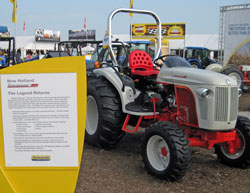 The New Holland Rustler utility vehicle isn’t the only attention grabber here at the Farm Progress Show. The retro Boomer 8N is also front and center. I spoke with New Holland Product Manager, Paul Trella, about their new products like the Boomer 8N.
The New Holland Rustler utility vehicle isn’t the only attention grabber here at the Farm Progress Show. The retro Boomer 8N is also front and center. I spoke with New Holland Product Manager, Paul Trella, about their new products like the Boomer 8N.
The latest addition to the company’s Boomer line, the redesigned 8N features distinctive, timeless styling, a Continuously Variable Transmission (CVT) that creates a fun, easy, car-like driving experience as well as a variety of customizable accessories. First sold in 1948, this updated version of the classic 8N is now available to consumers seeking reliable power wrapped in a compact and time-honored package.
Of course the Rustler is also getting attention and Paul says customers are saying, “It’s about time.” Of course you can get the new vehicles in New Holland blue but you can also customize them in camo or black or probably any color you’d like. I’ve got several photos of them in our photo album.
You can learn more about the new things from New Holland in my interview with Paul below and you can see the Rustler in action in this video clip:
Farm Progress Show Photo Album
AgWired coverage of the 2009 Farm Progress Show
is sponsored by:  and
and 
Zimfo Bytes
- Ag Leader Technology, Inc., announced new and enhanced industry file format support from the market-leading SMS Basic and SMS Advanced precision farming desktop software.
- NAFB is initiating its third major national research study in four years, with the Internet Ag Information Usage Study commissioned with Ag Media Research, Sioux Falls, S.D.
- T-L Irrigation Co., announces the availability of a 3-wheel tower option. The 3-wheel option can be used with any non-towable pivot tower that has or will be encountering problems with machine flotation.
- Livestock Publication gala set for Oct. 30: Two outstanding individuals will be honored and their portraits unveiled and hung in the LPC Hall of Honor during the American Royal.

New Era in Weed Management
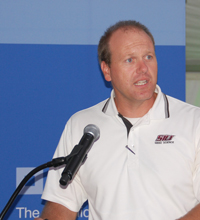 Glyphosate resistance is a growing problem for growers in the Midwest, according to Dr. Bryan Young with Southern Illinois University, who gave a presentation on the issue and how to handle it at the BASF tent during Farm Progress Show 2009.
Glyphosate resistance is a growing problem for growers in the Midwest, according to Dr. Bryan Young with Southern Illinois University, who gave a presentation on the issue and how to handle it at the BASF tent during Farm Progress Show 2009.
“Without a doubt it is growing,” Bryan says. “The largest problem is the glyphosate resistant mare’s tail but now we are seeing resistant waterhemp showing up, it’s present in several states now.” Bryan says growers need to start implementing different strategies, using a combination of weed control, to help prevent the spread or even the evolution of resistant weeds on their own operations.
Dr. Young was also on the Kixor panel in the BASF theater this week, talking about the new chemistry and the Kixor-powered herbicides that are awaiting final registration from EPA any day now.
See photos of BASF at Farm Progress Show here on Flickr.
Listen to or download an interview with Bryan Young talking about weed management and the Kixor products:
New Hay Tools From New Holland
 A major focus for New Holland here at the Farm Progress Show is their lineup of haying equipment. I spoke with Gary Wojcik who provided an overview of all the different products New Holland has just introduced.
A major focus for New Holland here at the Farm Progress Show is their lineup of haying equipment. I spoke with Gary Wojcik who provided an overview of all the different products New Holland has just introduced.
Products include: BR7000 Series Round Balers, Carted Wheel Rakes, Crop Mergers,
H6000 Series Disc Mowers, H7000 Series Discbine® Disc Mower-Conditioners,
H8000 Series Speedrower® Self-Propelled Windrowers, Automatic Bale Wagons, BB9000 Series Large Square Balers, BC5000 Series Small Square Balers, Roll-Belt™ Round Balers and Tedders.
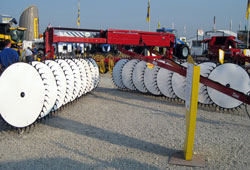 Gary says one of the newest tools in the lineup is their Heavy Duty wheel rake.
Gary says one of the newest tools in the lineup is their Heavy Duty wheel rake.
New Holland’s new H5980 heavy-duty wheel rake is built for the rigorous demands of hay growers requiring high-speed, high-volume, flat-land raking. The rake can be operated at speeds as high as 15 mph.
With eight 60″ raking wheels on the left side and nine on the right, the H5980 rakes an area up to 30’3″ wide. This offset design turns all the crop, ensuring uniform crop drydown. There’s no need for a center kicker wheel, so the operator can drive faster. A convenient hydraulic adjustment allows the operator to change windrow width from the tractor seat to produce a finished windrow as wide as 72″.
Gary says most of these products will be available by year end and now is a good time to pre-order which will also help them plan their production to meet customer’s needs.
You can listen to my interview with Gary below:
Farm Progress Show Photo Album
AgWired coverage of the 2009 Farm Progress Show
is sponsored by:  and
and 
Bird’s Eye View of Farm Progress Show
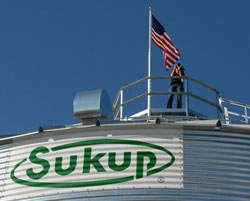 Today I had the privilege of climbing to the top of a five story Sukup grain storage bin to get a bird’s eye, 360 degree view of the grounds of the Progress City. Standing high above the crowd I could see and snap photos of the record crowds and all of the exhibits and activities going on below me. Although I was shaking the whole way up the staircase, due to my fear of heights, I tried to capture the energy and beautiful weather we have had this week.
Today I had the privilege of climbing to the top of a five story Sukup grain storage bin to get a bird’s eye, 360 degree view of the grounds of the Progress City. Standing high above the crowd I could see and snap photos of the record crowds and all of the exhibits and activities going on below me. Although I was shaking the whole way up the staircase, due to my fear of heights, I tried to capture the energy and beautiful weather we have had this week.
It was pretty spectacular to look over the entire expanse of the site after walking ground level up and down the streets on foot or riding in a golf cart – or the New Holland Rustler! I was very impressed with the effort put forth by the exhibitors, the beautiful landscaping and how each exhibit seemed to be more inviting than the next.
 Even though I have been exposed to agriculture all of my life because of my parents’ careers, I guess I never knew how really interesting it is. Chatting with my parents about how the corn fields look and what chemicals they use on them is not usually in our everyday conversation!
Even though I have been exposed to agriculture all of my life because of my parents’ careers, I guess I never knew how really interesting it is. Chatting with my parents about how the corn fields look and what chemicals they use on them is not usually in our everyday conversation!
I have learned so much about corn and soybeans and yield and machinery these past couple of days, I have a new appreciation for the people who produce the food that I eat every day. Farming is pretty darn hard work and a lot more complicated than most people probably think.
The weather really has been incredibly beautiful – everyone says it is the best weather they have ever had for the show. No rain, no excessive heat, not brutally cold. Is this Progress City or Panama City? If it will be like this again next year, sign me up!
Check out more of my bird’s eye view photos on the Farm Progress Show Photo Album
AgWired coverage of the 2009 Farm Progress Show
is sponsored by:  and
and 
